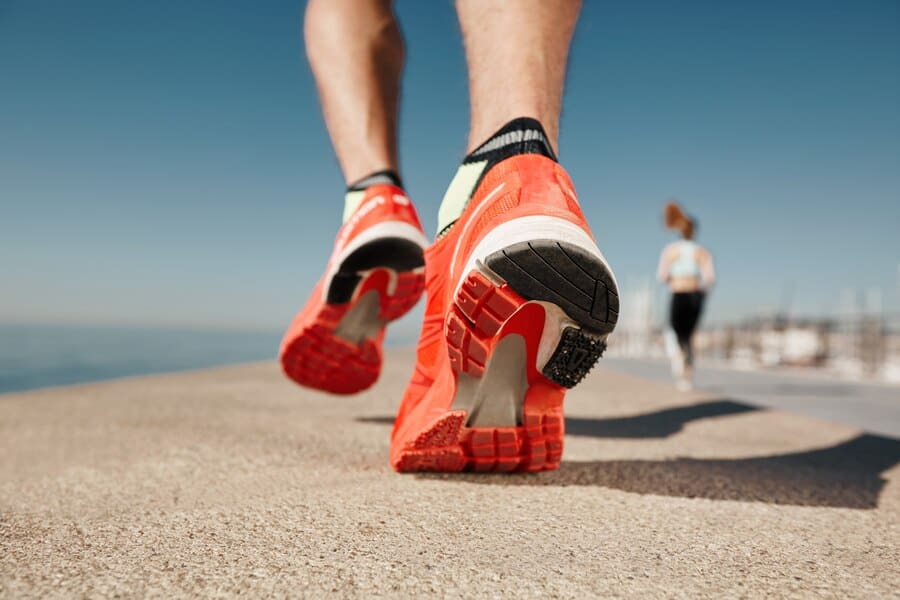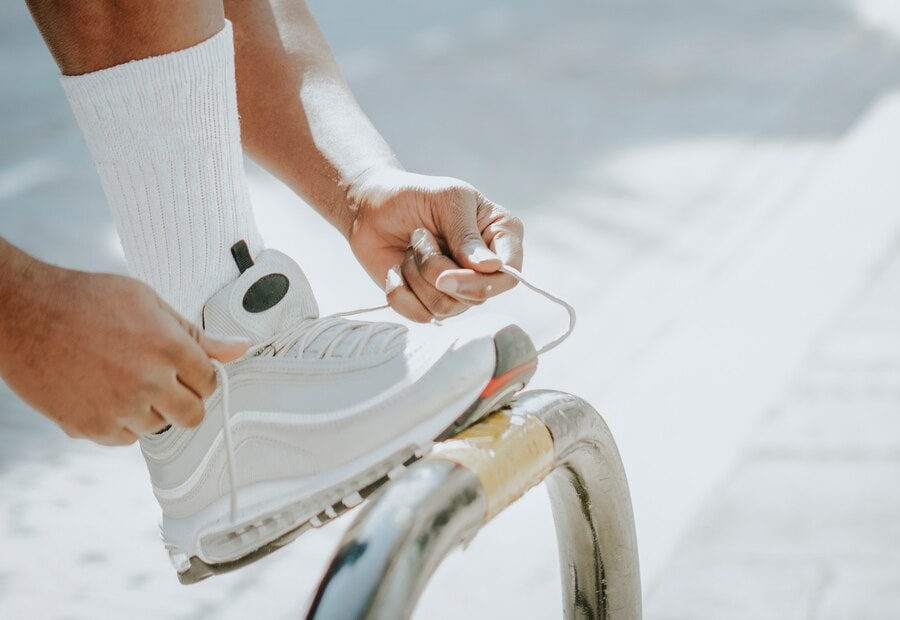
Running Shoes vs Tennis Shoes: Key Differences
Did you know that there are fundamental differences between running shoes and tennis shoes?
While they may seem similar at first glance, these two types of athletic footwear are designed to fulfill specific requirements and enhance performance for their respective sports.
Whether you’re a dedicated runner or an avid tennis player, understanding the disparities between running shoes and tennis shoes can greatly impact your comfort, stability, and overall athletic performance.
In this article, we will explore the key differences between these two types of shoes and highlight their unique characteristics.
Key Takeaways:
- Running shoes and tennis shoes have distinct design and construction to cater to the specific demands of each activity.
- Performance and functionality features differ between running shoes and tennis shoes, including grip, support, and flexibility.
- Comfort and cushioning levels vary between the two types of shoes, influencing overall wearability and impact absorption.
- While each type of footwear excels in its designated sport, there can be instances of cross-sport use depending on individual preferences and requirements.
- Understanding the differences between running shoes and tennis shoes will enable you to make informed decisions when selecting the right pair for your athletic endeavors.
Construction and Design
The construction and design of running shoes and tennis shoes are specifically tailored to meet the unique requirements of each sport.
Let’s compare popular models like Asics Court FF vs FF2 and Asics Court FF vs Gel Resolution 8, as well as explore the differences between Asics and Nike tennis shoes.
Asics Court FF vs FF2
When it comes to Asics tennis shoes, the Court FF and FF2 models are among the top choices for professional players and enthusiasts alike.
These shoes are built with superior technology and materials to enhance performance on the court.
Asics Court FF vs Gel Resolution 8
Another popular comparison in the Asics tennis shoe lineup is the Court FF and Gel Resolution 8.
Both models offer unique features and advantages, catering to different playing styles and preferences.
“The Asics Court FF is known for its lightweight design, optimal support, and responsive cushioning. On the other hand, the Gel Resolution 8 offers exceptional stability and durability, with Gel technology in the forefoot and rearfoot for enhanced shock absorption. The Flexion Fit upper provides a secure and adaptable fit, while the AHAR+ outsole delivers outstanding traction and durability on various court surfaces.”
Differences between Asics and Nike Tennis Shoes
Aside from comparing Asics models, it’s important to understand the distinctions between Asics and Nike tennis shoes.
Both brands have their own unique technologies and innovations that cater to the specific needs of tennis players.
“Asics is known for its gel cushioning system, which provides excellent shock absorption and comfort. Nike, on the other hand, focuses on technologies like Zoom Air and Lunarlon for responsive cushioning and energy return. Additionally, Nike incorporates Flyknit and Flywire technologies into their tennis shoe designs for lightweight support and a locked-down fit.”
Performance and Functionality
When it comes to athletic footwear, performance and functionality are key considerations.
Running shoes and tennis shoes are designed with specific features to optimize performance on the track or the court.
Court Shoe vs Running Shoe
Court shoes and running shoes have distinct characteristics that cater to the demands of their respective sports.
Court shoes, also known as tennis shoes, are designed to provide stability, support, and quick lateral movements on the court surface.
They feature non-marking outsoles that offer excellent traction without leaving scuff marks.
Additionally, court shoes often have reinforced toe caps and durable uppers to withstand the rigors of tennis.
On the other hand, running shoes are optimized for forward movement and cushioning.
They have responsive midsoles and cushioned heels to absorb impact and provide enhanced shock absorption during repetitive motions.
Running shoes also feature breathable uppers and flexible outsoles to promote airflow and natural foot movement.
Gel Resolution 7 vs 8
When comparing performance between running shoes, the Gel Resolution 7 and Gel Resolution 8 from Asics bring notable updates and improvements.
The Gel Resolution 7 is known for its exceptional stability and durability.
It features Asics’ signature Gel cushioning system, providing maximum shock absorption and comfort for long-distance running.
The upper is constructed with Flexion Fit technology, offering a snug and supportive fit.
It features Asics’ FlyteFoam cushioning, which delivers a lightweight and responsive feel.
The outsole incorporates AHAR technology, providing excellent durability and grip on various court surfaces.
Indoor Court Shoes vs Running Shoes
When considering indoor activities such as indoor tennis or fitness training, indoor court shoes offer specific advantages.
These shoes are designed with non-marking outsoles suitable for indoor surfaces.
They prioritize traction and lateral support to accommodate quick changes in direction on the court.
While running shoes may provide cushioning and shock absorption, their outsoles are not optimized for the demands of indoor court sports.
Training Shoes vs Tennis Shoes
Training shoes, also known as cross trainers, are versatile footwear options that are suitable for a range of activities, including both running and court sports like tennis.
They are designed to provide a blend of cushioning, stability, and lateral support to accommodate a variety of movements.
However, for sports that involve specific and repetitive motions, such as tennis, using specialized tennis shoes is recommended for enhanced performance and injury prevention.
Overall, the choice between court shoes, running shoes, or training shoes depends on the specific sports and activities you engage in.
While athletic footwear offers a range of performance features, selecting the right shoe for your needs is crucial to optimize your performance and prevent injuries.
Court Shoes |
Running Shoes |
|
|---|---|---|
| Performance | Optimized for quick lateral movements on the court | Designed for forward motion and cushioning |
| Support | Stability and lateral support | Cushioning and shock absorption |
| Outsole | Non-marking with excellent traction | Flexible and optimized for grip |
| Upper | Durable construction to withstand rigors of tennis | Breathable and flexible materials |
| Recommended for | Tennis and court sports | Running and general athletic activities |
In the next section, we will delve into the comfort and cushioning aspects of running shoes and tennis shoes.
Comfort and Cushioning
When it comes to both running shoes and tennis shoes, comfort and cushioning are key factors that can greatly impact your performance and overall experience.
Let’s explore the differences between tennis shoes and sneakers, discuss the comfort and cushioning features of popular models like Wilson Kaos vs Rush Pro, and compare tennis shoes to running shoes in terms of comfort and suitability as walking shoes.
First, let’s differentiate between tennis shoes and sneakers.
While these terms are often used interchangeably, there are subtle distinctions between the two.
Tennis shoes, specifically designed for the sport, typically provide enhanced lateral support, stability, and durability on the court.
Sneakers, on the other hand, encompass a broader category of athletic footwear that may not have the same specialized features as tennis shoes.
Now let’s turn our attention to specific models, such as the Wilson Kaos and Rush Pro, which are popular choices among tennis players.
On the other hand, the Rush Pro prioritizes stability and support, making it ideal for players who require greater control during aggressive movements on the court.
Comparing tennis shoes to running shoes in terms of comfort, running shoes typically have more cushioning and shock absorption to minimize the impact on your feet and joints while running.
This extra cushioning is essential for long-distance runners who need optimal support during extended periods of activity.
However, this additional cushioning in running shoes may not be as suitable for the quick lateral movements and explosive bursts required in tennis.
Additionally, tennis shoes can also serve as comfortable walking shoes due to their supportive construction.
The stability and cushioning provided by tennis shoes make them a favorable choice for individuals who engage in regular walking activities, providing the necessary comfort and protection for extended periods of walking.
Overall, when considering comfort and cushioning, it’s important to match the specific footwear to the intended activity.
Running shoes prioritize cushioning for long-distance running, while tennis shoes offer the necessary support and stability for quick movements on the court.
Whether you’re choosing between tennis shoes and sneakers or deciding on the right tennis shoe model like Wilson Kaos vs Rush Pro, finding the right balance of comfort and performance is crucial.
Versatility and Cross-Sport Use
While running shoes and tennis shoes are designed with specific sports in mind, there are often discussions around their versatility and potential cross-sport use.
Let’s delve into some common questions and explore whether running shoes and tennis shoes can serve dual purposes.
Are running shoes and tennis shoes the same?
Although both running shoes and tennis shoes fall under the broader category of athletic footwear, they are designed with distinct features that cater to the specific demands of each sport.
Running shoes prioritize cushioning, shock absorption, and support for forward motion, while tennis shoes focus on lateral stability, durability, and traction for quick and multidirectional movements on the court.
Can running shoes be used for tennis?
Running shoes may not provide the necessary stability and lateral support required for the quick side-to-side movements in tennis.
The cushioning and flexibility of running shoes are optimized for forward motion, which may compromise stability and increase the risk of ankle injuries on the tennis court.
Do running shoes work for tennis?
While running shoes can offer some level of comfort and support on the tennis court, they are not specifically designed to withstand the unique demands of tennis.
The absence of features such as reinforced toe caps and specialized outsoles for traction on hard courts can limit the performance and durability of running shoes in a tennis setting.
What’s the difference between running and tennis shoes?
Running shoes and tennis shoes differ in various aspects, including design, cushioning, support, traction, and durability.
Running shoes prioritize forward motion, cushioning, and shock absorption, while tennis shoes focus on lateral stability, durability, and traction for multidirectional movements on the court.
What is the difference between running and tennis shoes?
The main difference between running shoes and tennis shoes lies in their design and functionality.
Running shoes are primarily built for forward motion, emphasizing cushioning, shock absorption, and flexibility.
On the other hand, tennis shoes are engineered for lateral movements, offering stability, durability, and traction to withstand the rigorous demands of tennis.
“While it may be tempting to use running shoes for tennis or vice versa, it’s important to recognize that each sport has unique requirements. Opting for footwear specifically designed for your chosen activity will help prevent injuries and enhance performance.”
Understanding the distinctions between running shoes and tennis shoes is crucial for choosing the right footwear that aligns with your sporting needs.
By selecting the appropriate shoes, you can optimize your performance, reduce the risk of injuries, and enjoy your chosen sport to the fullest.
Conclusion: Running Shoes vs Tennis Shoes: Key Differences
After exploring the construction, performance, comfort, and versatility differences between running shoes and tennis shoes, it is evident that each type of footwear is tailored to meet the specific requirements of its respective sport.
Understanding these distinctions is crucial in optimizing your performance and overall experience on the track or court.
When it comes to construction and design, running shoes and tennis shoes have unique features that cater to the demands of running and tennis.
From midsole cushioning to outsole traction, each shoe is engineered to provide the necessary support and stability for the specific movements involved in its respective sport.
Comfort and cushioning are also important factors to consider.
Both running shoes and tennis shoes prioritize comfort, but they offer different levels of cushioning and support.
Depending on your preferences and foot type, you can choose a shoe that provides the right amount of cushioning for your sport and playing style.
Lastly, while there may be some instances where running shoes can be used for tennis or vice versa, it is generally recommended to use footwear specifically designed for your sport.
The unique performance features and technical specifications of running shoes and tennis shoes ensure that you have the optimal equipment for maximizing your potential and minimizing the risk of injury.
Related read: Accessories: Empowering Your Wardrobe
FAQ
What are the key differences between running shoes and tennis shoes?
Running shoes and tennis shoes have distinct differences in their construction and design, performance and functionality, comfort and cushioning, and versatility for cross-sport use. Understanding these variances is crucial for optimizing your performance and overall experience in running or playing tennis.
How are running shoes different from tennis shoes in terms of construction and design?
The construction and design of running shoes and tennis shoes are tailored to meet the specific requirements of each sport. For example, tennis shoes typically feature a sturdy outsole and lateral support to handle the repetitive side-to-side movement on the court, while running shoes prioritize cushioning and flexibility to absorb impact while maintaining forward motion.
What are some popular models to compare in terms of construction and design?
Two popular models to compare are Asics Court FF vs FF2 and Asics Court FF vs Gel Resolution 8. These examples illustrate the variations in design and functionality between different tennis shoe options. Additionally, comparing Asics and Nike tennis shoes can show the differences in construction and design between these brands.
How do running shoes and tennis shoes differ in terms of performance and functionality?
Running shoes and tennis shoes offer different performance and functionality features based on the demands of the respective sports. Court shoes, designed for tennis, provide excellent traction and stability for quick lateral movements on the court, while running shoes prioritize cushioning and support for forward motion and impact absorption. Additionally, comparing models like Gel Resolution 7 vs 8 can highlight specific performance differences.
What are the differences between tennis shoes and sneakers in terms of comfort and cushioning?
Tennis shoes and sneakers have distinct differences in terms of comfort and cushioning. While tennis shoes are designed with specific features to provide support and stability for lateral movements on the court, sneakers are typically more versatile and may prioritize style over specialized sports functionality. However, some sneakers do offer cushioning and comfort features similar to tennis shoes.
Can running shoes be used for tennis?
While running shoes may provide some level of comfort and cushioning, they may not offer the necessary support and stability required for playing tennis. Tennis shoes are specifically designed to handle the quick side-to-side movements and providing the appropriate traction on the court. It is generally recommended to use tennis shoes when playing tennis to avoid potential injuries and optimize performance.
What is the difference between running shoes and tennis shoes in terms of versatility and cross-sport use?
While running shoes and tennis shoes are designed for specific sports, there may be instances where their versatility allows for cross-sport use. However, it’s important to note that the design and functionality of each type of shoe may not be optimized for the other sport. Therefore, it’s generally recommended to use running shoes for running and tennis shoes for playing tennis to ensure the best performance and minimize the risk of injuries.
Can running shoes be used for walking or as everyday shoes?
Running shoes can be suitable for walking or as everyday shoes due to their cushioning and support features, but it’s important to consider the specific needs of walking and everyday activities. Walking shoes are engineered to provide stability and comfort specifically for walking, while running shoes prioritize impact absorption and forward motion during running. Assessing your individual needs and comfort preferences can help determine the best shoe for walking or everyday use.
What is the conclusion regarding the key differences between running shoes and tennis shoes?
After examining the key differences in construction and design, performance and functionality, comfort and cushioning, and versatility, it is clear that running shoes and tennis shoes cater to the specific demands of each sport. Understanding these distinctions is essential for selecting the appropriate footwear to optimize your performance, prevent injuries, and enhance your overall experience on the track or court.








